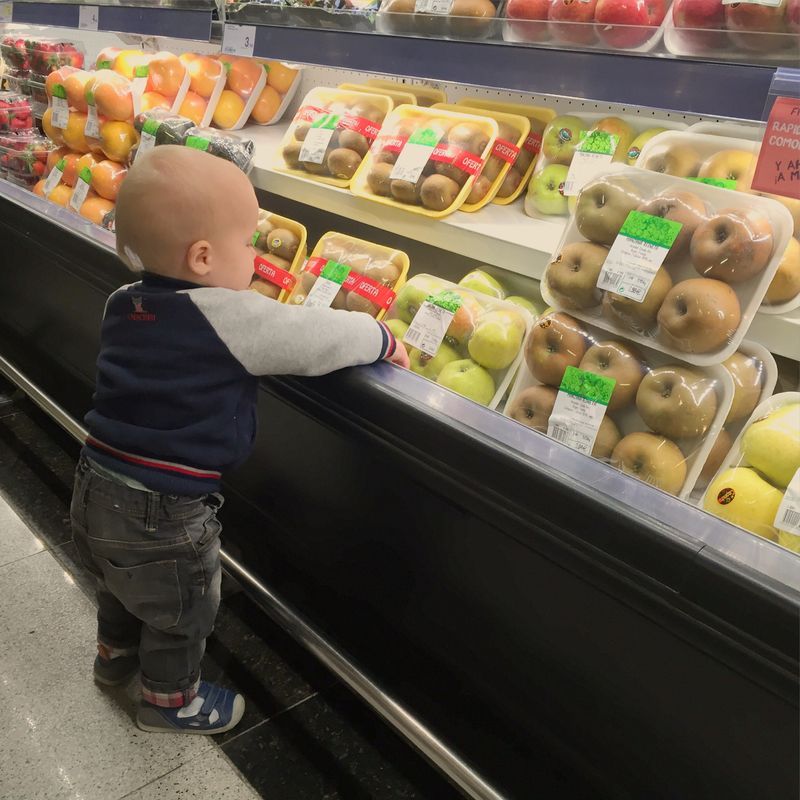The supermarket is the gym of the will power
After telling you about how we Paleo (yes, I just used it as a verb), I promised I would tell you about how we choose and buy products at the supermarket, because that’s where we really try to be Paleo. Our number one rule is to buy only good, healthy products that are as natural and fresh as possible. That’s how we don’t have any temptation at home and we manage to live 90% Paleo.
Let me be clear, though: it’s not easy! When we pass by the chocolate bar section, shelves lined with cakes, the quadruple-chocolate cookies, the fridges full of Ben&Jerry’s ice-cream… well, it’s hard not to give in. Especially because yummy products are always in strategic places: they either welcome you at the door, or say bye-bye to you at the register. There’s no way around them.
That’s why I like to think of supermarkets as the gym for your will power: when it comes to eating healthy, that’s where you train your mind to rule your stomach—and not the other way around.
Now, play a little game with me. Picture yourself at the supermarket. Imagine you managed to walk past the naughty foods, look at all of them and resist the temptation of sticking them in your cart. I bet you feel awesome, empowered. Now give yourself a pat on the shoulder and promise yourself you’ll do the same thing next time you go buy your groceries. And congrats, you’ve just trained your will power!
Unfortunately, the common naughty foods are not all the bad foods you can buy. Healthy eating has an even worse enemy: the ingredients on the label of ”healthy” foods.
Always read the ingredients!
In an ideal world, we’d avoid all processed foods and buy all organic from a small farm, where they pick veggies and fruit straight from the garden and butcher their own meat. That’s not only difficult to find, it’s also very costly.
Let’s be realistic here: it’s likely you’ll have to compromise and buy processed foods. Tomato sauce, tuna, mayo, cheese, minced meat…
But when buying processed foods, looking at the ingredients can make a huge difference.
I started reading the ingredients of the products I buy when I first heard the story of this mom and her daughter. It really hit me: food companies feed us cr** in the shape of healthy foods! Sugar is in everything. Vegetable oil is in almost everything.
Pretty much all the artificial foods we buy in stores are full of MSG, which is related to many disorders and mental diseases. You can read more about it here, if you like.
You may argue that worrying about what food companies put in our foods is like worrying because the air we breathe is polluted. Yes, in a way you’re right. But unlike breathing polluted air—which is something you can’t avoid if you choose to live in the city—reading the ingredients of the products you buy is a way to empower ourselves, to choose what to eat in a conscious, mindful way.
The fewer, the better
When it comes to processed foods, the fewer ingredients, the better. And among those few products with few ingredients, the more natural, the better. Avoid margarine, vegetable oil, sugar.
If you have the option to choose between a vegetable oil based mayo and an olive oil based one, pick the olive oil one: it’s more natural and has healthy fats. Pick a minced meat that doesn’t contain corn, wheat flour or soy (yes, they often do!).
Let me give you a simple example: I often buy a carton of carrot soup by Knorr, which I like to have in emergencies (aka. when Oliver wouldn’t eat anything else). Knorr has many different soup combinations, but I only buy the carrot one because it’s the only one that doesn’t have sugar in it (for real!) and it also has very few ingredients. When I want a pumpkin soup, I’ll make it myself. Without sugar, please.
The earlier an ingredient is listed, the more of it there is
Ingredients are listed by quantity, so if the first ingredient in your chocolate bar is sugar, it means that sugar is the main ingredient—that there’s more sugar than cocoa, or anything else.
It might sound silly, but the position where an unhealthy ingredient is listed can make a big difference in the quality of the product and in its nutritional values.
Easier than it seems
It might sound difficult, but it’s really not. It just takes practice and a bit of extra time at the beginning to read and compare ingredients, but once you know which products are good and which are not, it’s actually even faster to shop, because options are limited.
I invite you to try using the supermarket as a gym for a month, to choose and buy mindfully: you might not notice a big change in your health (or maybe you will!), but I promise you you’ll feel much better about yourself and your healthier way of eating.








